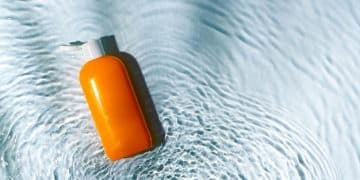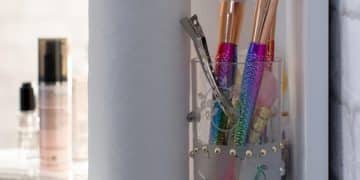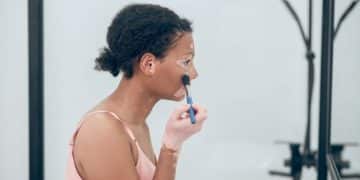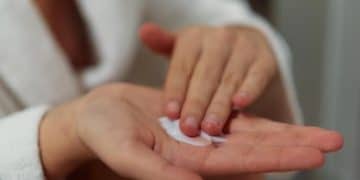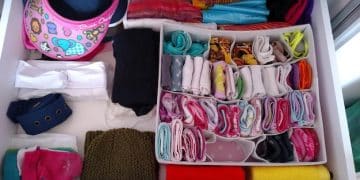Is Your Makeup Expiring? 2025 Guide to Shelf Life & Usage
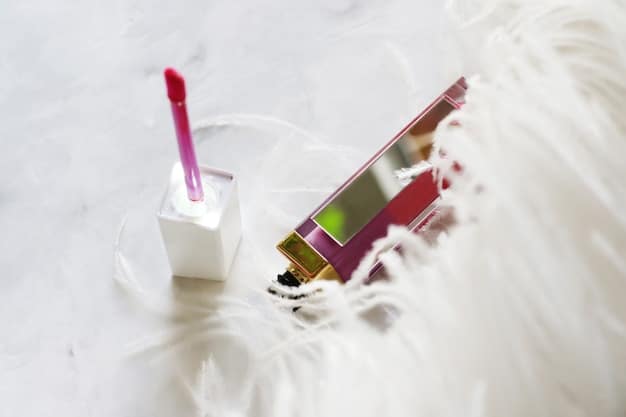
Anúncios
Maintaining the integrity and safety of makeup products is crucial for skin health, and understanding their expiration dates and proper storage in 2025 prevents irritation, infection, and maintains product performance.
Are you wondering, is your makeup expiring? A 2025 guide to shelf life and safe usage is essential for anyone who uses cosmetics. Just like food, makeup products have an expiration date, and using them past their prime can lead to various skin issues and compromise their effectiveness. This comprehensive guide will walk you through everything you need to know about makeup shelf life, how to identify expired products, and best practices for safe usage in 2025.
Anúncios
The Hidden Dangers of Expired Makeup
Using expired makeup isn’t just about poor performance; it poses genuine risks to your skin and eye health. Over time, cosmetic formulas break down, preservatives degrade, and bacteria can multiply, turning your favorite products into potential hazards.
Beyond the immediate concerns, prolonged exposure to degraded ingredients can sensitize the skin, leading to chronic issues. This makes understanding the warning signs even more critical for long-term health and beauty.
Bacterial Contamination: The Invisible Threat
Every time you open a product or apply it to your skin, you introduce microbes from your fingers, brushes, and the surrounding environment. While most fresh products contain preservatives to combat this, these preservatives aren’t eternal.
Anúncios
- 🦠 **Bacteria Growth:** As preservatives weaken, bacteria like Staphylococcus and Pseudomonas can thrive, especially in moist environments like mascaras or liquid eyeliners.
- 👁️ **Eye Infections:** The eyes are particularly vulnerable. Using expired eye makeup can lead to conjunctivitis, styes, or even more severe infections.
- 🧴 **Skin Irritations:** For facial products, expired items can cause rashes, redness, breakouts, and general irritation, particularly if you have sensitive skin.
These contaminants are often invisible to the naked eye, meaning you might not even realize your product is compromised until symptoms appear. Regular checks and adherence to expiration guidelines are your first line of defense.
Formula Degradation and Efficacy Loss
Beyond microbial risks, the chemical composition of makeup degrades. This alters the product’s texture, color, and overall performance. You might notice changes long before any visible mold or smell appears.
For example, foundations might separate, lipsticks can dry out and become crumbly, and powders might become chalky. This not only makes application difficult but also means you’re not getting the intended benefits of the product.
The active ingredients in skincare-makeup hybrids, such as SPF or anti-acne agents, are also susceptible to degradation. An expired product with SPF, for instance, might offer little to no sun protection, leaving your skin exposed.
Understanding PAO (Period After Opening) Symbols
The most common and important indicator of a product’s shelf life once opened is the PAO symbol. This small icon looks like an open jar with a number followed by the letter ‘M’ (for months), such as ‘6M’ or ’12M’.
This symbol represents the recommended number of months you can safely use the product after opening it. It’s crucial because the chemical stability and bacterial resistance of a product change significantly once exposed to air and human contact.
For instance, a mascara marked ‘6M’ should be discarded six months after you first unscrew its cap, regardless of its printed manufacturing date. This is due to the high risk of bacterial transfer to the eyes with each application.
Why PAO is More Important Than Manufacturing Date for Opened Products
While some products might have a manufacturing or “best by” date, the PAO symbol is typically the primary guide for opened cosmetics. Unopened, most cosmetics have a shelf life of approximately 30 months (2.5 years) from their manufacturing date.
However, once the seal is broken, the clock starts ticking on the PAO. This is because oxygen exposure can break down active ingredients and preservatives, and the introduction of applicators or fingers can introduce bacteria that will then multiply.
Keeping track of opening dates can be challenging, but simple methods like using a small permanent marker to write the opening date on the product itself can be incredibly helpful for adhering to PAO guidelines and ensuring safe use.
Makeup Shelf Life by Product Type in 2025
Not all makeup products expire at the same rate. Factors like water content, packaging, and application method play significant roles. Understanding these differences can help you manage your makeup collection more effectively.
Knowing the typical shelf life for each category empowers you to make informed decisions about when to repurchase and what to discard. This also helps in planning your makeup purchases to minimize waste.
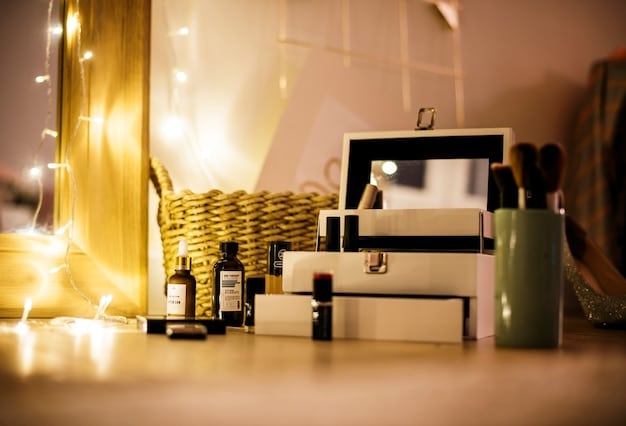
Liquids and Creams: The Fastest to Expire
Products with high water content are prime breeding grounds for bacteria once exposed to air. This category includes foundations, concealers, liquid blushes, cream eyeshadows, and particularly, mascaras and liquid eyeliners.
- Mascara & Liquid Eyeliner: 3-6 months. These are the most susceptible to bacterial growth due to repeated exposure to the eye area and air pumped into the tube with the wand.
- Liquid Foundation & Concealer: 6-12 months. The presence of water and oils makes them prone to separation and bacterial contamination. Look for changes in texture, smell, or color.
- Cream Blush & Eyeshadow: 6-12 months. Similar to other liquid/cream products, they can harbor bacteria and degrade in texture over time.
Always avoid pumping the wand in and out of mascara tubes, as this pushes air and bacteria into the product, accelerating its spoilage. For liquid foundations, consider pump dispensers to reduce direct contamination.
Powders and Solids: Longer Lasting
Powder-based products like eyeshadows, blushes, bronzers, and pressed powders generally have a longer shelf life due to their low water content. Lipsticks and lip glosses also fall into this category but require specific considerations.
- Powder Eyeshadow, Blush, Bronzer, & Pressed Powder: 1-2 years. While less prone to bacterial growth, their surface can still get contaminated from brushes. Regular cleaning of brushes is key.
- Lipstick: 1-2 years. They can dry out or change in texture and smell. If a lipstick develops an unusual odor or waxy film, it’s time to toss it.
- Lip Gloss: 6-12 months. Similar to liquid products, the wand repeatedly goes in and out, introducing bacteria. Watch for stickiness, separation, or a strange smell.
Even with longer shelf lives, proper hygiene is paramount for solid products. Always ensure your brushes are clean before touching the product, and avoid sharing lipsticks or glosses to prevent cross-contamination.
Pencils and Liners: The Most Durable
Because they can be sharpened, pencil products like eyeliners and lip liners offer a unique advantage in terms of hygiene. Each sharpening shaves off the exposed layer, effectively removing accumulated bacteria.
- Eye & Lip Pencils (Sharpenable): 1-2 years. Regularly sharpening them helps maintain their cleanliness, as the tip that touches your skin is constantly refreshed.
Gel or liquid pot liners, however, behave more like liquid products and should be discarded within 6-12 months due to repeated brush dipping. Always keep the caps tightly sealed on all liners to prevent drying out and contamination.
Signs Your Makeup Has Expired (Even Before the PAO)
While PAO symbols offer a guideline, sometimes products can expire sooner due to poor storage or contamination. It’s crucial to pay attention to sensory clues that indicate spoilage.
These signs are your product’s way of telling you it’s no longer safe or effective to use. Trust your senses first, even if the PAO date hasn’t been reached yet.
Changes in Texture or Consistency
One of the most obvious signs is a noticeable alteration in the product’s feel. For liquid foundations, separation of oil and water is a clear red flag. You might see a layer of oil floating on top, or the product might become lumpy or gritty.
Powders may become hard-panned, making them difficult to pick up on a brush. Cream products might dry out and become crumbly, losing their smooth application. Mascaras and liquid eyeliners often become thick, clumpy, or flaky when expired.
These textural changes not only make the product perform poorly but often indicate a breakdown of the formula or the growth of microorganisms within the product itself.
Unusual Odor
Cosmetics are formulated with specific scents, or they might be completely fragrance-free. Any deviation from the original smell, such as a rancid, sour, or chemical odor, is a strong indicator of spoilage.
This is often due to the oxidation of oils within the product or the proliferation of bacteria, which produce metabolic byproducts that smell unpleasant. Don’t try to mask the smell with fragrance or essential oils; it signifies a deeper problem.
If your product smells “off” in any way, even if subtle, it’s safer to discard it immediately, especially for products applied near the eyes or mouth.
Color Changes and Discoloration
Expired makeup can sometimes undergo subtle or obvious color changes. A foundation might oxidize and turn orange, a concealer might become patchy, or a neutral eyeshadow could develop a greenish tint.
These changes are typically caused by chemical reactions within the formula as it breaks down, or they can be a visual cue of bacterial or fungal growth. Mold can appear as small black, green, or white spots on the surface of cream or liquid products.
Even if the color change is slight, it suggests the product’s integrity is compromised and its original pigments are no longer stable or safe for application.
Best Practices for Extending Makeup Shelf Life and Safe Usage
While you can’t defy expiration dates, good hygiene and proper storage can help your makeup last as long as safely possible and prevent premature spoilage. These practices are crucial for the integrity of your products.
Adopting these habits not only prolongs the life of your cosmetics but also helps maintain their performance and ensures they remain safe for your skin.
Storage Savvy: Keeping Products Cool and Dark
Heat, light, and humidity are the enemies of makeup. Storing products in a cool, dark, and dry place away from direct sunlight and temperature fluctuations is paramount.
- ☀️ **Avoid Sunlight:** Direct sunlight can break down active ingredients, pigments, and preservatives, leading to separation and spoilage.
- 🌡️ **Maintain Stable Temperatures:** Extreme heat can melt and destabilize formulas, while cold can cause separation or crystallization. Avoid storing makeup in bathrooms where temperatures and humidity often fluctuate significantly.
- 🧊 **Refrigerate Some Products?** While not necessary for all makeup, natural or organic products with fewer preservatives, certain eye creams, or face mists might benefit from refrigeration, extending their freshness. Always check product instructions.
A vanity drawer or a dedicated makeup bag in a bedroom closet are often ideal storage locations, offering stable temperature and minimal light exposure. For products that come with specific storage instructions, always follow them diligently.
Hygiene Habits: The Key to Preventing Contamination
Your hands, brushes, and sponges are common carriers of bacteria. Practicing impeccable hygiene prevents these microbes from transferring into your makeup products, which can then be reapplied to your skin, leading to issues.
- 🧼 **Wash Your Hands:** Always wash your hands thoroughly before applying makeup, especially when using fingers to dip into pots or jars.
- 🧹 **Clean Brushes and Sponges Regularly:** Brushes and sponges accumulate oils, dead skin cells, and bacteria. Clean brushes weekly with a gentle brush cleanser or mild soap and water, and replace sponges monthly.
- ❌ **Avoid Sharing Makeup:** Sharing makeup, especially eye and lip products, is a direct path to cross-contamination. Each person introduces their unique microbiome, increasing the risk of infection.
- ✏️ **Sharpen Pencils:** For sharpenable eye and lip pencils, sharpen them before each use to remove the exposed, contaminated layer.
Consider using spatulas or clean cotton swabs to scoop out cream products from jars instead of dipping your fingers directly. This minimizes the introduction of bacteria and extends the product’s usable life.
When to Replace vs. Repair Your Makeup
Sometimes, a product might seem “off,” but it’s not necessarily expired. Knowing when to simply rectify an issue versus when to discard a product is crucial for both safety and minimizing waste.
However, it’s vital to err on the side of caution. If there’s any doubt about a product’s safety, especially for sensitive areas like the eyes, it’s always best to replace it.
Fixing Dried-Out Products (with Caution)
Some products, especially those that are oil or water-based, might appear to dry out or thicken prematurely. Mascara and liquid eyeliner are common culprits. While tempting to add water or saline solution, this is almost always a bad idea.
- 💧 **Mascara:** If mascara has dried out, it generally means it’s full of air (and likely bacteria). Adding water or saline dilutes the preservatives and can introduce more bacteria, creating a breeding ground for infection. Replace it.
- 💦 **Gel Eyeliner:** For gel pot liners that have dried slightly, a tiny drop of a cosmetic-grade mixing medium (not water or saliva!) can sometimes revive them, but proceed with extreme caution and discard if the smell or texture is off.
- 🧴 **Cream Products:** For slightly dried cream foundations or concealers, a drop of facial oil or setting spray *might* help restore consistency in a pinch, but watch for a change in smell or separation.
It’s important to remember that these “fixes” are temporary and don’t address potential bacterial contamination. If a product frequently dries out, it might indicate poor sealing, and replacement is the safest option.
Dealing with Broken Powder Products
Breaking a powder compact (blush, eyeshadow, pressed powder) is a common mishap. Thankfully, these can often be salvaged as long as they haven’t been contaminated by dirt or foreign substances.
To fix a broken powder compact:
- Gather the broken pieces and crush them into a fine powder.
- Add a few drops of rubbing alcohol (isopropyl alcohol) to create a paste.
- Press the paste back into the compact using a clean spatula or the back of a spoon, smoothing the surface.
- Allow it to dry completely for 24-48 hours.
The alcohol evaporates, leaving the powder re-pressed. This method doesn’t affect the product’s shelf life, as alcohol is a disinfectant. However, if the product was already near its PAO or showed other signs of expiry, a broken compact is a good excuse to discard it.
Navigating Makeup Shopping in 2025: Informed Choices
Being an informed consumer in 2025 means not just knowing when to throw out old makeup, but also making smart purchasing decisions that support product longevity and safety. This involves understanding packaging and buying habits.
Smart shopping can reduce waste and ensure you’re always using fresh, effective products. Consider your usage habits before making impulse purchases.
Prioritizing Smart Packaging
The way a product is packaged significantly impacts its exposure to air and bacteria. Opt for packaging that minimizes contamination.
- 💨 **Airless Pumps:** These systems prevent air from entering the product, greatly extending the life of foundations and moisturizers.
- 💉 **Squeeze Tubes:** Products in squeeze tubes (like some concealers or liquid blushes) offer better protection than jars, as they limit direct air and finger contact.
- 🚫 **Open Jars:** While common, products in open jars (e.g., cream eyeshadows, potted foundations) are most susceptible to contamination. Always use a clean spatula or thoroughly washed hands when accessing these items.
While aesthetics are important, prioritizing hygienic packaging can save you money in the long run by extending product freshness and reducing the risk of skin irritations. Always ensure caps are tightly sealed after each use to prevent exposure.
Buying Habits: Less is Often More
It’s tempting to stock up on sales or hoard limited-edition collections. However, buying excessive amounts of makeup can lead to products expiring before you have a chance to use them up.
Consider your personal usage frequency. If you only wear mascara occasionally, a smaller tube might be more cost-effective and safer than a large one that will expire before you finish it. Focus on quality over quantity.
Rotate your products, using older items first. And remember, makeup trends come and go, but healthy skin and eyes are permanent. Investing in fewer, fresher products is a wiser approach to your beauty routine in 2025.
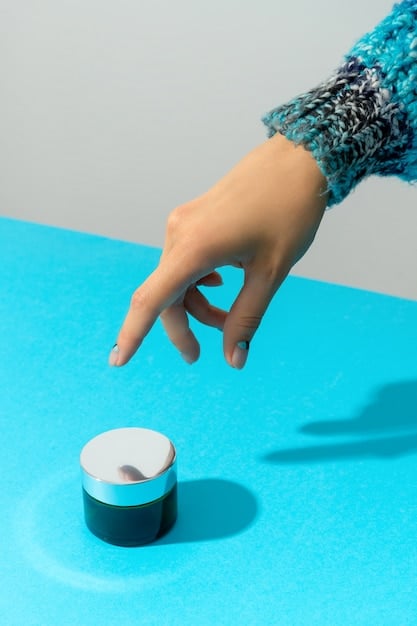
| Key Takeaway | Brief Description |
|---|---|
| ⏰ PAO Matters | Period After Opening is the key expiry indicator for opened makeup. |
| 🦠 Spotting Spoilage | Look for changes in texture, smell, or color as signs of expired makeup. |
| 🧼 Hygiene is Key | Regularly clean brushes and avoid sharing products to prevent contamination. |
| ❄️ Proper Storage | Store makeup in cool, dark places away from heat and direct sunlight. |
Frequently Asked Questions About Makeup Expiration
It is generally not recommended to use makeup past its Period After Opening (PAO) date, even if it appears normal. The breakdown of preservatives and potential bacterial growth can occur invisibly, posing a risk of irritation or infection, especially for sensitive areas like the eyes.
The PAO symbol is a small icon resembling an open jar with a number and ‘M’ (e.g., ‘6M’ or ’12M’) inside. It indicates the recommended number of months a product can be safely used after it has been opened for the first time.
Proper storage in cool, dark, and dry conditions minimizes exposure to heat, light, and humidity, which can all degrade product formulas and break down preservatives. This helps maintain the product’s stability and efficacy for its intended shelf life.
Yes, products with high water content are generally more susceptible to bacterial contamination and spoilage. Mascara and liquid eyeliner typically have the shortest shelf life (3-6 months), followed by liquid foundations and concealers (6-12 months).
Absolutely. Using expired makeup can lead to various skin issues, including breakouts, rashes, irritation, and allergic reactions. For eye products, it can cause infections like conjunctivitis or styes. The risks outweigh any benefits of using an old product.
Conclusion
Staying informed about is your makeup expiring? A 2025 guide to shelf life and safe usage is not just about extending the life of your beloved cosmetics; it’s fundamentally about protecting your health. By understanding PAO symbols, recognizing signs of spoilage, and adopting diligent hygiene and storage habits, you can ensure your beauty routine remains both effective and safe. Always prioritize your skin and eye health by regularly auditing your makeup bag and replacing products when their time is due.
